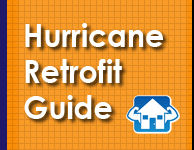|
Porous and Non-Porous Systems
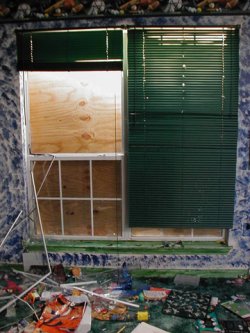
|
This window failure was the result of positive pressure; it blew in when the pressure exceeded the strength of the glass. As you can see it was protected with plywood but the glass still broke. No evidence of any impact from flying debris could be found. This window was a wind rated Design Pressure (DP) 45 Single Hung (SH) unit with insulated glass (1/8" thick); positive pressure behind the plywood against the glass caused the failure. This window met the current building code requirements for wind pressure resistance on this house.
The children were in the room when the glass failed; thankfully no one was hurt just very scared. This is why you should stay away from openings during a hurricane even if they are protected.
(click image for larger version) |
|
There are two types of shutters; porous and non-porous. Porous type shutters have open areas around their edges or on their surface that equal more than 5% to 10% of the area covered by the shutter. This allows air and water to pass through or around them. Some have as much as 50% open area. They provide impact protection and rely on the door or window they are protecting to resist the wind pressures; both negative pressures (those directed away from the house) and positive pressures (those directed towards the house). So, porous systems block windborne debris and are usually built out far enough that they will not deflect into the glass when impacted by the standard 9-pound 2x4 lumber missile traveling at 34 mph. However, they do not do a good job of reducing wind pressures or water leaks. The result is that windows and doors behind them experience the full effect of the wind pressures and will leak about as much as an un-protected window. If the windows are not strong enough they can be blown in, which allows wind and even more water to enter the house.
Non-porous type shutters are designed to reduce the likelihood that internal pressurization of the house will result, regardless of whether the door or window fails from pressure or indirectly from missile impact. That is, they protect independently of the door or window behind them. They keep the opening somewhat sealed against internal pressurization of the house that might result from failure of a window or door.
As a result, porous shutters should be used only when the protected windows or doors are wind pressure rated. In contrast, nonporous shutters can be used in any situation.
Porous systems:
Some examples of Porous shutters are:
- Perforated steel or woven stainless steel screens.
- Some conditions of direct mount or build-out mount corrugated panel shutters if the edges are left open.
- Open louvered shutters like Bahama Awnings and or Colonial Hinged Shutters where wind can pass freely between the slats.
- Some Roll-Up and Accordion Shutters when built-out from the structure
- Any system that requires a build-out may create a porous condition unless all sides are enclosed; all systems that are approved with a Miami-Dade Notice of Acceptance (NOA) require separation or build-out to reduce contact with the window or door being protected.

|
This home has direct mount non-porous metal panels installed only 2 inches away from the glass it is protecting. Using building code definitions for porosity, the window on the right is considered porous since the panels are shorter than the 38" minimum span required by the manufacturer's engineering to qualify as non-porous. This opening would have required a different solution or had the ends of the corrugations boxed in to qualify as non-porous.
(click image for larger version) |
|
When a shutter receives impacts or wind pressure they bend or deflect. A build-out involves mounting the shutter far enough away from the window or door so that it does not contact the door or window when it deflects. In other words, that means the shutter does not cause the window to break. If the build-out is not boxed in around the sides, a gap is created between the wall and the shutter where wind can flow into the opening if the window or door fails. If the build-out creates an aggregate opening of 5% to 10% or more of the area of the window or door, it may change the shutter from a non-porous system to a porous one. Openings larger than this can cause pressurization of a house. The idea is that the gaps create a large enough opening to allow wind flow to overcome any leaks on other walls and the roof and build up pressure in the house (internal pressurization).
When porous shutters are used in applications where the glass is predominately 3/16" or thicker plate glass or high strength tempered glass, the window and shutter together offer acceptable protection from both windborne debris and wind pressures. Jalousie windows do typically have 3/16”, but most windows glass is only 1/8“ thick.
Non-Porous Shutters:
The basic idea is that the openings around the protective system, or those that may be caused by the impact of the standard test missile, will not be large enough to allow the internal pressure in the house to increase because the door or window being protected fails. However, this does not mean that the system will keep wind pressures from being applied to windows and doors and perhaps causing them to burst open or shatter.
Research has shown that it doesn't take much of a gap or hole to allow pressures on the outside of the shutter to build up on the window or door unless it is a really leaky window or door. Consequently, weak windows and doors or ones that have been poorly or improperly installed may still fail, even if they are protected by a non-porous shutter.
Some examples of non-porous shutters are:
- Impact glass windows and doors (fenestration)
- Flexible screen or fabric systems with very low porosity
- Light gauge metal panel systems (depending on minimum lengths)
- Polycarbonate, Polypropylene, or other plastic corrugated panel systems, clear or translucent
- Most accordion shutters
- Flat polycarbonate sheets either monolithis (that like glass) or cellular (honey combed)
- Most roll-up shutters
- Bahama Awning shutters (with perforated backer plates or non-vented)
- Colonial Hinged shutters (non-vented)
- Plywood (minimum 1/2" thick) or OSB (minimum 7/16" thick)
Though some of these shutters look like they would be porous, for example corrugated panel systems, they are non-porous because although they do let air and water pass around or through them, they do it to a low enough extent that it is not a big threat to the house. This is what testing has shown.
Because windows and doors on houses being built before June 1, 2002 at locations outside of Miami-Dade and Broward Counties were not required to be pressure rated, non-porous shutters are a good choice for these homes. These shutters offer a higher level of protection against internal pressurization of the house regardless of the rating of the window or door being protected. Furthermore, outside Miami-Dade and Broward Counties, non-porous shutters do not require build-outs or separation from the doors or windows being protected, this substantially reduces the cost and visual impact of the systems. However, a moderate to strong impact or even the wind pressure may still break the glass.
Once you are north of the frost line (think Interstate 4), most windows are being replaced with insulated glass to reduce energy consumption. For these applications, impact glass window and door systems may be a poor choice because the pressures may break the insulated seals requiring replacement. Similarly, the outside piece of glass can be easily broken by even small debris since it is not laminated and this will also require replacement of the glass units. Non porous shutters that fit tight to the opening will generally offer a greater degree of protection from water penetration; but, large debris impacts may cause the glass to break. It is important to consider all your options and choose the system that meets your budget and the protection level you desire.
How to Select Approved Shutters:
As you can tell from the lists above of porous and non-porous shutters there are many kinds of shutters, each with unique advantages and some disadvantages. The following provides a brief look at a number of the shutters available. You can also click on
HRG_Shutter_Matrix.pdf
to review and print a listing of information on many of the types of shutters currently available. New products are constantly being developed and brought to market. The following text and photographs and the matrix do not cover all the options.
 One way to pre-screen manufacturers and products is to check their membership in the
International Hurricane Protection Association
(IHPA). Manufacturer who are members of the IHPA, a not-for-profit trade association, have all submitted products for independent testing and engineering. Member manufacturers produce products that have the necessary Texas Department of Insurance, Miami-Dade and/or FBC approvals for use in Florida and Texas. This is important because buying an unapproved system means you will not be eligible for windstorm insurance annual premium discounts, and the strength or reliability of the system is unknown. It is possible to waste your investment in a protection system or on a product that may provide poor protection or is virtually worthless or will not qualify for insurance premium discounts. If you look for the IHPA logo at dealers and manufacturer's websites this will help identify systems that are compliant with the Florida Building Code and the International Building Code.
One way to pre-screen manufacturers and products is to check their membership in the
International Hurricane Protection Association
(IHPA). Manufacturer who are members of the IHPA, a not-for-profit trade association, have all submitted products for independent testing and engineering. Member manufacturers produce products that have the necessary Texas Department of Insurance, Miami-Dade and/or FBC approvals for use in Florida and Texas. This is important because buying an unapproved system means you will not be eligible for windstorm insurance annual premium discounts, and the strength or reliability of the system is unknown. It is possible to waste your investment in a protection system or on a product that may provide poor protection or is virtually worthless or will not qualify for insurance premium discounts. If you look for the IHPA logo at dealers and manufacturer's websites this will help identify systems that are compliant with the Florida Building Code and the International Building Code.
In order to verify that shutters are approved for use in Miami-Dade or Broward counties you can visit the
Miami-Dade Building Code Compliance Office
website, or, for all other Florida counties visit the
Florida Building Code Product Approval
website.
Find the manufacturers name, then you can look up the type of shutter and select from the drop down menus or approval numbers listed for a manufacturer.
If the manufacturer's name is not on the list, then you may be purchasing a product that is not tested or approved. If the manufacturers name comes up but there are no products listed then they could be just starting the approval process. In this case you should wait until the shutters are approved. Many times shutters are improved or modified during the testing and approval process. If you buy before the system is approved you may be getting a prototype that will differ from the final approved product.
One of the greatest risk for poor shutter performance is the installation.
Corrugated Metal Panel Systems (Porous and Non-Porous):
Metal panel shutters fall in the lowest cost category and are available in an increasingly wide variety of thicknesses and include:
- Galvanized Steel
- Galvalume Steel
- Mill Finish Aluminum (unpainted)
- Painted Aluminum
- Perforated Aluminum (let's light in)
Since panel shutters are deployed when a hurricane or storm is approaching, they require preparation time and storage space. While they offer effective protection, they are difficult to install above the first story. Because of their relatively low cost, consider using these for openings at lower heights in combination with permanent mounted systems for upper stories, this is an effective way to reduce the overall cost of shuttering a home.
Because shutters are installed from the outside of the home, consider replacing one or two entry doors with pressure and impact rated ones, or install shutters that can be opened easily from inside the home (accordion or roll-up shutter) to provide an emergency escape route. The building code requires at least one means of egress through an exterior door that can be operated from inside your home. You might want to consider having two escape openings in case one becomes unusable or inoperable because of damage from debris or a tree. Garage doors for cars can be a backup method of egress, but should not be counted on because they may become distorted to the point they cannot be opened even by hand.

|
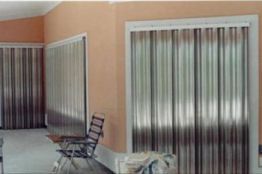
|
Both of the pictured panel installations use track systems, by closing off the tops of the panels these would be considered Non-porous. Track systems also reduce the time needed to deploy the system as a storm is threatening since only one end needs to be fastened with wing nuts. An advantage of these shutters is that each is light and easy to carry.
(click image for larger version) |
Clear Polycarbonate and Translucent Polyethylene Corrugated Panel Shutters (Non-Porous):
Since many Floridians have become familiar with plywood and metal shutters, they have also discovered what it's like to shelter in a home with no light. Manufacturers have created a variety of clear and translucent panels to solve this problem. While these are more expensive than traditional metal panel systems, they can be placed on just a few windows to allow light in areas like bathrooms, kitchens, and bedrooms. You can also mix clear panels with metal panels if the manufacturer has tested the system mounted in that configuration. Many people that select corrugated metal panels include a single polycarbonate panel with a matching corrugation in one window on each side of the house so they can let in light and get a feel for what may have happened around the house. In addition, some people include several polycarbonate panels for the window in the room they expect to use as their shelter. But remember that one should never stay in an outside room that, at the moment, faces the hurricane winds. One never can be sure that debris will not penetrate shutters or walls. Why take the risk?
 CAUTION: Before mixing clear or translucent panels into an existing metal panel system check with the manufacturer to insure you use an approved panel and that their engineering does not include any extra fasteners or limitations of use. You do not want to weaken or compromise a previously installed and approved system.
CAUTION: Before mixing clear or translucent panels into an existing metal panel system check with the manufacturer to insure you use an approved panel and that their engineering does not include any extra fasteners or limitations of use. You do not want to weaken or compromise a previously installed and approved system.
|
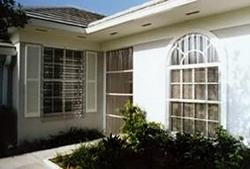
|

|
Some clear panels can be used alone but some require a metal panel on each side to support them. Make sure you check the manufacturers engineering before using all clear panels. This is a system that uses polyethylene or Polyolefin which is translucent to allow light in. Polyolefin is pictured; it is more translucent than polyethylene.
(click image for larger version) |
Cellular Polycarbonate and Polypropylene 4 foot x 8 foot Sheets (Non-Porous):
Shutters made from cellular polycarbonate and polypropylene sheets. These are shutters designed to be an alternative to plywood. The polycarbonate and polypropylene have a honeycomb, extruded design, creating a lightweight and strong panel; both allow light in. The drawback of these systems is that they require that all four sides be attached, if you have projected sills, architectural accents that project at different dimensions, or windows that terminate at the soffit system you may not be able to attach all four sides.
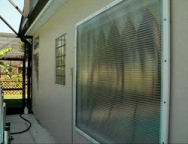
|

|
Newer cellular polycarbonate or polypropylene sheets attached with frame on all four sides allow light into home- exterior and interior views.
(click image for larger version) |
|
 In many cases to get code approvals, sheet products must be attached on all four sides. The particular product shown above uses a frame system to retain the Cellular Polycarbonate. The cellular polypropylene product below uses individual anchors on all four sides.
In many cases to get code approvals, sheet products must be attached on all four sides. The particular product shown above uses a frame system to retain the Cellular Polycarbonate. The cellular polypropylene product below uses individual anchors on all four sides.
The systems are designed to allow natural light into the room.
|
 CAUTION: You should never attempt to look out or even sit in the chair by the window shown in this picture. An impact during a hurricane would spray very sharp pieces of glass possibly severely injuring any occupant of the chair.
CAUTION: You should never attempt to look out or even sit in the chair by the window shown in this picture. An impact during a hurricane would spray very sharp pieces of glass possibly severely injuring any occupant of the chair.
|
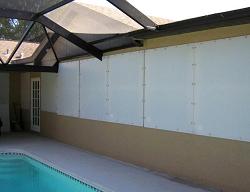
|

|
Opaque panels let light into home - exterior and interior views.
(click image for larger version) |
Monolithic Polycarbonate Sheets (Non-Porous):
Monolithic polycarbonate sheeting is a little different in that it has close to the same optical clarity of glass but since it is a solid sheet it is relatively heavy. This is the same product used to make some impact resistant windows and doors as well as over-glazing systems. The most commonly recognized use is in jet airplane windows or even skylight systems. The clear sheets come in XL-10 ® and MR-10 Margard ®. Both types have a 10 year warranty against defects when exposed to sun. The MR-10 Margard is the better product since it incorporates a UV coating on both sides with an additional mar-resistant coating that helps protect against scratches and weathering. XL-10TM has only one side coated and will scratch easily. The only approved monolithic systems on the market have an integral frame system that allows the panel to expand and contract. Placing fasteners directly through the sheet is not recommended as an impact may split the wall around the fastener and cause the attachment to fail. If these shutters are not exposed to sun for long, then the extra cost of sun protection may not be justified.
Screen Protection Shutters (Non-Porous):
There are some applications that are difficult to protect with traditional shutters, for these screen shutters may be the perfect solution. These systems fall in the low to mid price range (generally $8.00 to $20.00 per square foot installed). These are non-porous shutters so they can be mounted with no separation or built-out depending on their use. However, many are installed with enough separation to reduce the chances of debris pushing the screen into contact with the window or door. Sometimes this is done by using ground anchors or attaching at the eaves. Like panels these are usually only deployed for a hurricane. However, some newer systems roll up into a hood or work like an accordion and are permanently mounted to the structure. Operation varies widely from system to system, some can be operated from inside but some are operated from the outside.

|
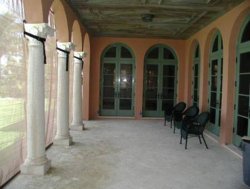
|
Outside and inside views: A screen protection system enclosing an entire porch or lanai helps to keep wind and flying debris away from the openings. As a result, you may opt to leave your patio furniture or other loose items from your yard outside for minimal hurricanes which saves on preparation time. For strong or severe hurricanes you may want to bring all loose items into the house or garage. Note the custom fit on the decorative column caps.
(click image for larger version) |

|

|
Before system deployment (right) and with the system deployed (left). This particular home has a huge amount of glass, this system was a good choice for protection, it not only decreased the cost of the overall protection, it was able to cover the large spans of glass without the use of build-out, storm bars or additional structural framing a traditional system would have required.
(click image for larger version) |
Fabric Panel Shutters (Non-Porous):
These low cost shutters use high strength fabrics that are flexible. This gives them several properties that increase their performance over traditional rigid shutters.
- Since they are flexible they can take repeated debris impacts with little or no damage
- They are very light weight, and do not require the storage space of plywood, panels, or polycarbonate and polypropylene sheets.
- They allow light to enter.
- Because they are also 100% waterproof they can be used for emergency roof repairs after the hurricane passes without the problems experienced with plastic tarps. They will not rot or disintegrate when left exposed to sun, and they will not tear when subjected to strong winds.
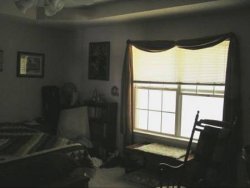
|
The fabric panels are translucent.
(click image for larger version) |
|
While these systems do offer advantages, their disadvantage is that they are flexible so they can come in contact with the glass or door that they are protecting thus there is the potential for them to allow the glass to be broken. However, even if the glass or door fails, the fabric shutter seals the opening against internal pressurization and to a lesser extent rain.
Accordion Shutters (Porous and Non-Porous):
These are mid-priced shutters ranging from $18 to $30 per square foot installed. The system operates from side to side and is permanently attached to the exterior. It can be operated from the outside or inside of the house with in-swing or sliding glass doors. It can also be operated from inside if the window is a slider, single or double hung. Operation from the inside is not possible with out-swing doors, casement windows, some jalousie windows, or fixed windows. Accordion shutters, like screen protection systems are also very effective at closing off large areas like patios or lanais. Unless the accordion panels have no joints, they have the potential to let wind driven rain behind the individual panels. Hurricane experience has shown that wind driven rain of even a modest hurricane can be driven behind roll down shutter panels and leak around the windows behind the shutters. It seems that the same risk would be present with accordion shutters that are made with individual panels.

|
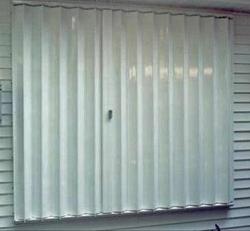
|
Typical images of stored and activated accordion shutter system.
(click image for larger version) |
Roll-Up Shutters (Porous and Non-Porous):
These are mid to high priced systems ranging from $28 (manual crank or pull-down) to $60 (motorized/automated) per square foot depending on the operation system selected. These shutters can be operated from inside, outside, remote control, or even automatically on any type window or door. If the roll-up panels are made with individual panels, they have the potential to let wind driven rain penetrate behind the panels. Hurricane experience has shown that when rain gets behind panels it can leak around windows and be deposited inside the house.

|

|
Roll-Up shutters are typically mounted under the eaves with the hoods exposed. Right: When the span reaches a certain width, additional vertical reinforcing bars called storm bars are used to keep the slats from coming out of the tracks under both positive and negative pressure.
(click image for larger version) |
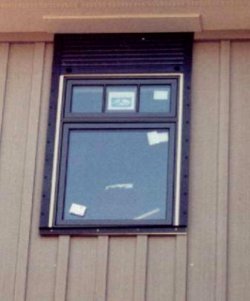
|
Hidden mount Roll-Ups completely hide the hood when built into the eave. However, this does add cost to the installation.
(click image for larger version) |
|
Fabric Pull-Down Shutters (Non-Porous):

|
Fabric pull-down shutter
(click image for larger version) |
|
These shutters are similar to roll down shutter systems except that they use fabric that is held in tracks at the sides and a bottom edge that locks into the frame at the bottom. These systems may offer advantages in reducing water intrusion and will protect from pressurization of the house. However, because they are flexible and usually mounted close to the glass, when they are impacted the glass is likely to break.
Colonial Hinged Shutters (Porous and Non-Porous):
These decorative accent shutters are among the highest priced shutters. They range in price from $40 to $60 per square foot. This popular style works well in historical districts or where a decorative feature is desired. The operation is generally from the outside only and requires installation of additional hardware or storm bars to keep them closed in a hurricane. The technology of shutters is evolving, a few inside locking systems are beginning to emerge on the market. Many of these systems are non-porous because they use a solid backing behind the slats.

|
These shutters add an attractive accent to the front of the home. Less expensive shutter systems were used elsewhere to reduce the overall cost of the job. One drawback is that the upper shutters must be operated from the outside which requires using a ladder to install the hurricane hardware. The owner decided that curb appeal outweighed the additional work required to close the shutters.
(click image for larger version) |
|
|
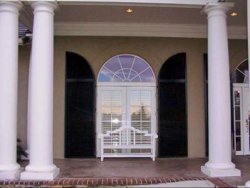
|
Colonial Hinged shutters can also be customized for a historical look; these are integral arch top shutters to cover the large arch top windows.
(click image for larger version) |
|
|
Bahama Shutters (Porous and Non-Porous
These are high priced systems ranging from $40 to $60 per square foot. Like the Colonial hinged shutters, these systems add a decorative accent. In addition they shade the windows and, like an awning, reduce heat gain through the glazing system. Some systems are designed to be operated from inside but the majority are designed for operation from the outside. Most also have additional hardware that must be added to secure the shutter for a hurricane. Most of these systems are Non-Porous shutters. The shutters in this picture are only impact resistant when the louvers are covered by a .040 aluminum sheet on the back, this blocks all visibility through the slats. Be advised that the vast majority of old Bahama shutters are almost completely ineffective for anything other than shade purposes. They are not well attached to houses and they are of such thin metal they cannot stop debris. In fact, they can be considered a hazard because in even modest hurricanes they will be torn off to become debris that could damage your house or your neighbor’s house.

|
This picture shows a decorative Bahama awning shutter system. Impact resistant shutters were not required in this area until 2002. Here again the owner opted for the decorative feature for curb appeal even though the shutters on the upper floor have to be closed from the outside using a ladder. The remaining openings were covered with metal panels to reduce the overall cost. Since those openings could be accessed from the decks the panels did not have to be installed from a ladder.
(click image for larger version) |
|
Perforated Steel Barrier Systems and Stainless Steel Woven Screen Barriers (Porous):
Due to the high porosity of these shutters, they are better suited for commercial applications where the windows and doors have much stronger glass and frame systems. The systems work well for schools that will be use for hurricane shelters since the system is in place 24/7/365, needs little or no maintenance and no additional labor to deploy. Some of the other benefits of these systems are reduced heat gain and glass breakage. They also provide vandalism protection.

|

|
Two examples of stainless steel screen protective systems on school buildings
(click image for larger version) |
Impact glass Windows, Doors, and Sliding Glass Doors (Non-Porous):
These products have the look of typical windows and doors but offer the benefit of 24/7/365 day protection. In fact they are much heavier than normal windows and doors and the frames are also much more robust than normal fare. The window systems are typically three times more expensive than the least expensive windows that meet the code pressure requirements. Sliding glass door systems can be four times the cost. However, when compared to premium windows from the same manufacturer, they typically only cost about 30% more. A disadvantage of impact glass is that when it is impacted and broken by debris replacement of the glass can be costly.

|
Impact resistant glass after impact by 2x4 missile - the glass breaks under impact by the standard missile but the missile does not penetrate through the membrane laminated between the interior and exterior glass panes.
(click image for larger version) |
|
Do-it-yourself Shutters
Back to Main Openings Page
|
